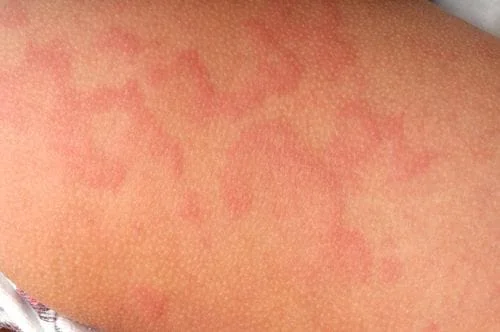
Hives are very itchy, red bumps that appear suddenly anywhere on the skin. Hives occur when mast cells in the skin release histamine. Histamine activates nerve cells that produce the sensation of itching and make small blood vessels dilate. Increased blood flow makes the skin red while leakage of plasma from the blood vessel is the cause of swelling. The medical term for hives is urticaria. What distinguishes urticaria from all other itchy rashes is that each hive lasts for minutes to hours and then disappears. Once the hive has resolved the skin returns to normal leaving no mark or bruise. The individual spots of itchy rashes last for weeks changing in appearance over time as they develop and then gradually fade away. When you have hives new spots may appear daily for weeks or months but an individual hive lasts no more than a single day. Hives are usually raised but may be flat. Smaller hive are red. Larger hives have a pale center surrounded by a ring of red skin. They never have crusting, oozing, or water or pus-filled blisters. They always itch.
Hives of the lips, eyelids and sometimes the face look like a hard lump without a sharp edge. These swellings are called angioedema. Angioedema either itch or burn. They resolve like hives within a day and leave no mark or bruise. When angioedema is present without any hives, especially when angioedema reoccurs frequently and is accompanied by abdominal pain or difficulty breathing a more serious condition called hereditary angioedema may be the cause. This condition is diagnosed by a blood test.

Hives come in three varieties:
- Acute hives lasting up to six weeks are most often the result of the immune system reacting to something that has entered the body like a food or drug or a viral or bacterial infection. For best results testing for the cause of acute urticaria should be performed three to six weeks after all hives have resolve.
- Chronic hives lasting more than six weeks are sometimes the result of an internal illness. Simple laboratory tests can determine if chronic urticaria is a symptom of some other disease.
- Physical urticaria is a form of chronic hives caused by an increased sensitivity of mast cells to external factors like pressure, heat, cold, vibration, sunlight and exercise.
Treatment
Most hives can be treated with antihistamines. Antihistamines block the action of histamine on nerve cells and blood vessels. They do not stop mast cells from releasing histamine. Antihistamines work best when taken before hives appear. Long-acting non-sedating antihistamines are preferred. Monoclonal antibodies is a new effective treatment for chronic hives not controlled by antihistamines. Prednisone may be used to suppress hives for a few days but have adverse effects when used for longer periods of time. Other immunosuppressive agents may be considered when monoclonal antibodies are not effective.